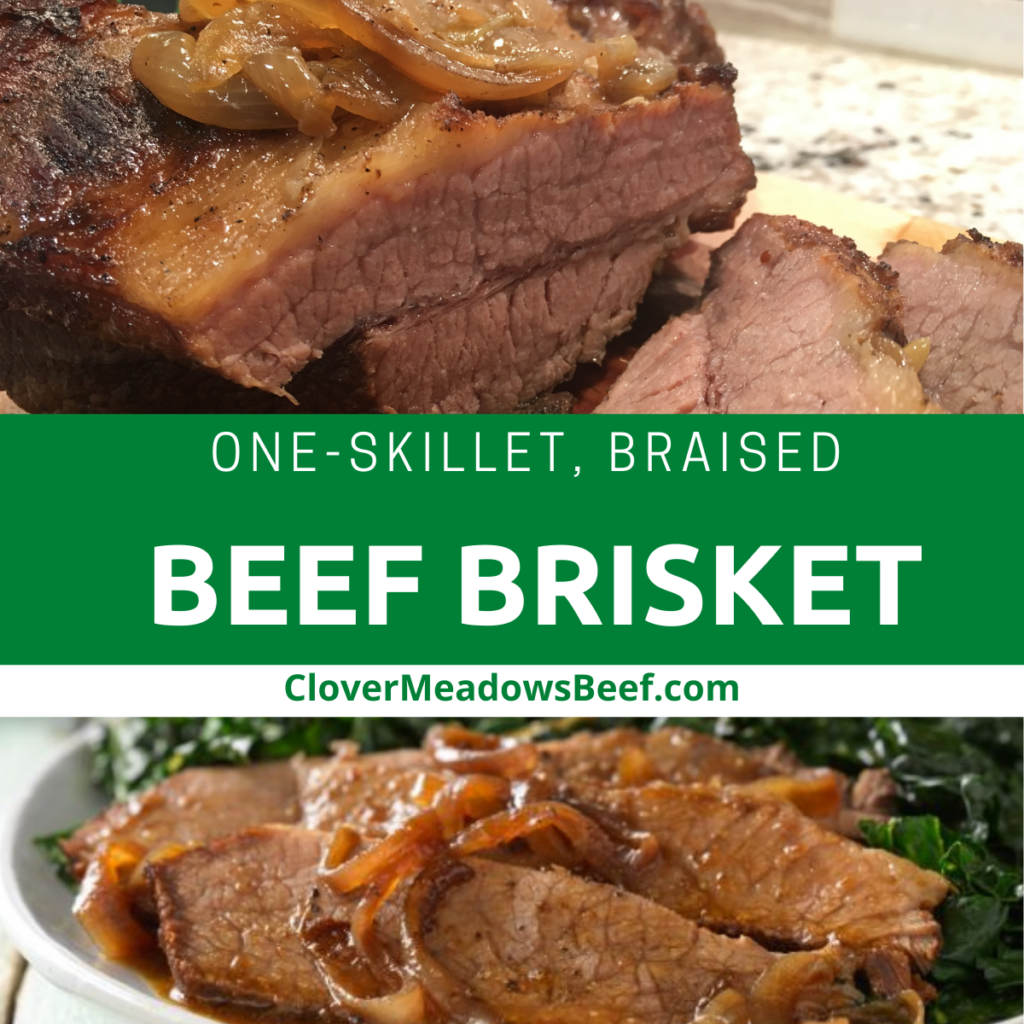
This post contains affiliate links. Please see our disclosure policy for more information
Brisket is one of our all-time favorite cuts. It’s an extremely versatile piece of beef that can be cooked in a variety of ways — from cooking brisket in the oven to smoking brisket.
We’ve run into many people that are intimidated by brisket because 1) they’ve heard it’s a tougher cut of beef or 2) they thought they had to have a smoker to make mouth-watering brisket.
It is correct that brisket is a tougher cut of beef since it comes from a muscle in the chest of the cow that’s heavily used. However, there is an easy solution for cooking it to make it tender — think low and slow (more on that later).
It’s not true that you have to own a smoker to make brisket. Don’t get us wrong, the thought of smoked brisket makes our mouths water. We’ll gladly be first in line to eat it! But, if you’re like us and don’t have a smoker (yet), it’s very doable to make mouth-watering, fall-apart tender brisket in the oven. If this is a new concept for you, keep reading and get ready to be impressed!
Ingredients for One-Skillet, Braised Beef Brisket
If you’ve followed our site for any length of time, you know we like simple recipes. This one fits our requirements with simple ingredients, one pan (we use a cast iron skillet), and once you place the beef in the oven you can walk away until it’s time to eat.
This unique thing about this brisket recipe is that it’s cooked with a massive heap of onions, which slowly carmalize and make an amazing flavor. If we are cooking a larger brisket, this is a great entree for gatherings with friends. If it’s a smaller brisket, this is a wonderful family meal with leftovers for the next day.
- This recipe uses a 4-5 pound beef brisket and will feed approximately 10 people. If for whatever reason you can’t find a brisket, you could make this with a chuck roast but the results won’t be quite as tasty.
- Salt is always an important part of seasoning beef. Kosher salt is typically our go-to since it’s coarse. The salt helps break down the beef’s muscle protein, draws moisture to the surface of the meat, and ultimately has a hydrating effect. Bottom line — it makes the brisket juicier.
- Onions and garlic are essential for flavoring. And yes, you really need 3 whole onions.
Is Brisket a Tough Cut of Beef?
Brisket is traditionally a tough cut of beef that becomes tender when it’s cooked properly — low and slow. The reason brisket is tougher is becuase it’s from the chest of the steer, between the shoulder and forelegs. This muscle gets a workout every day, which means it has a lot of collagen and connective tissue.
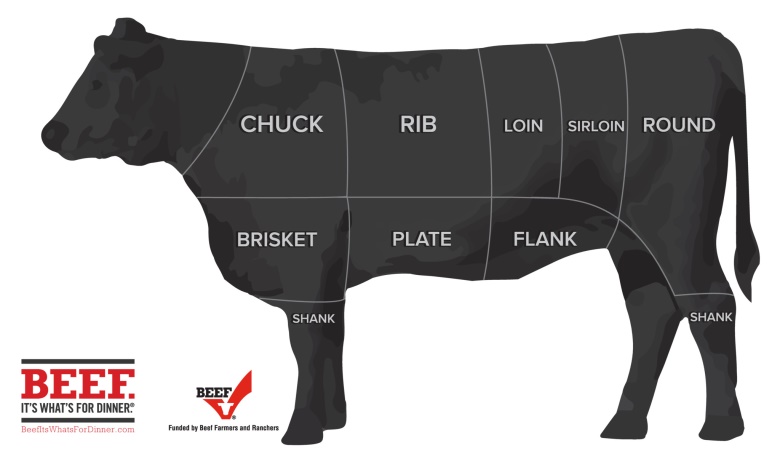
Brisket 101: Flat Cut vs. Point Cut
Brisket is made of two different muscles, which are separated by a thick layer of fat. There’s the flat (a.k.a. first cut, the leaner end) and the point (a.k.a. second cut, the fat end).
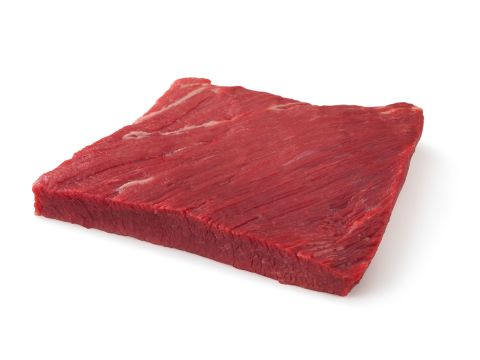
A whole brisket can weigh anywhere from about 5 to 20 pounds. Usually, grocery stores sell brisket as either the flat or point, not a whole brisket. If you want a whole brisket, you’ll need to go to a local butcher or a local farmer.
If you’re not ready to tackle a whole brisket yet, we recommend starting with either the flat or point cut. It’ll be a slightly smaller piece of beef, and will be easier to cook.
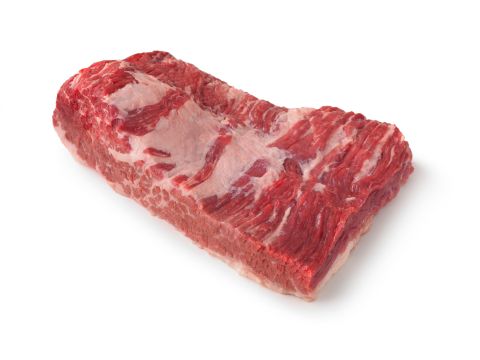
When cooking a whole brisket, remember that the flat and point cook differently — this is why cooking brisket can be so tricky! The flat is slightly leaner than the point and is easier to overcook. The point is very well-marbled and needs a longer cook time.
As a side note, an interesting fact that usually surprises people is that there is only one brisket per animal. When you purchase a quarter or half beef from Clover Meadows Beef, you are “cow-pooling” with others and splitting all the beef in the animal, including the brisket. This means with a quarter or half beef you won’t get a whole brisket. Instead, you’ll get amazing flat and point briskets that will melt-in-your-mouth.
Does Brisket Get More Tender the Longer it’s Cooked?
When you cook brisket on a low heat for a long time, the connective tissues dissolve and the beef becomes more tender. Often times, you’ll hear people say brisket must be cooked “low and slow”, and they’re right. This tough cut of beef is made ultra tender by cooking it low and slow in the oven.
How to Season Beef Brisket
Seasoning with salt is an important step for any piece of beef. When we cook a brisket in the oven, we always season with kosher salt and place it in the refrigerator 8-24 hours before cooking it. The salt helps break down the beef’s muscle protein, draws moisture to the surface of the meat, and ultimately has a hydrating effect. Bottom line — it makes the brisket juicier.
How Many Hours Does Brisket Take in the Oven?
Remember, patience is a must when cooking brisket! It needs to cook for about 40 minutes per pound, and we recommend using a digital meat thermometer (this is our favorite). The end goal is fork tender brisket. Yum!
A good rule of thumb is to add an hour of cooking time for every additional pound of beef. For example, a 5-pound roast should be baked at 300°F for 5 hours, and a 1-pound roast for 1 hour.
Should I Cover the Brisket in the Oven?
To keep the brisket moist while cooking in the oven, cover the skillet very tightly with aluminum foil (preferably heavy-duty or two layers) or a lid.
How Much Brisket Per Person?
The recommended serving size for brisket is 1/2 pound of uncooked meat per person. That said, brisket shrinks when it cooks more than any other cut of beef. So, our rule of thumb is 1 pound of brisket per person we’re serving. That will provide plenty of beef and also give you a little for leftovers.
What Internal Temperature is Brisket Cooked to?
According to a study done by Cook’s Illustrated, “To achieve tender and juicy brisket in a reasonable amount of time (about 4 hours), the key is to hold the meat between 180 and 200 degrees.”
You may be tempted to turn up the heat as it cooks, but don’t! A higher heat could make the brisket become tough.
If you want to monitor the beef as it cooks, you can use a thermometer with a leave-in oven probe. We really like the ChefAlarm by Thermoworks.
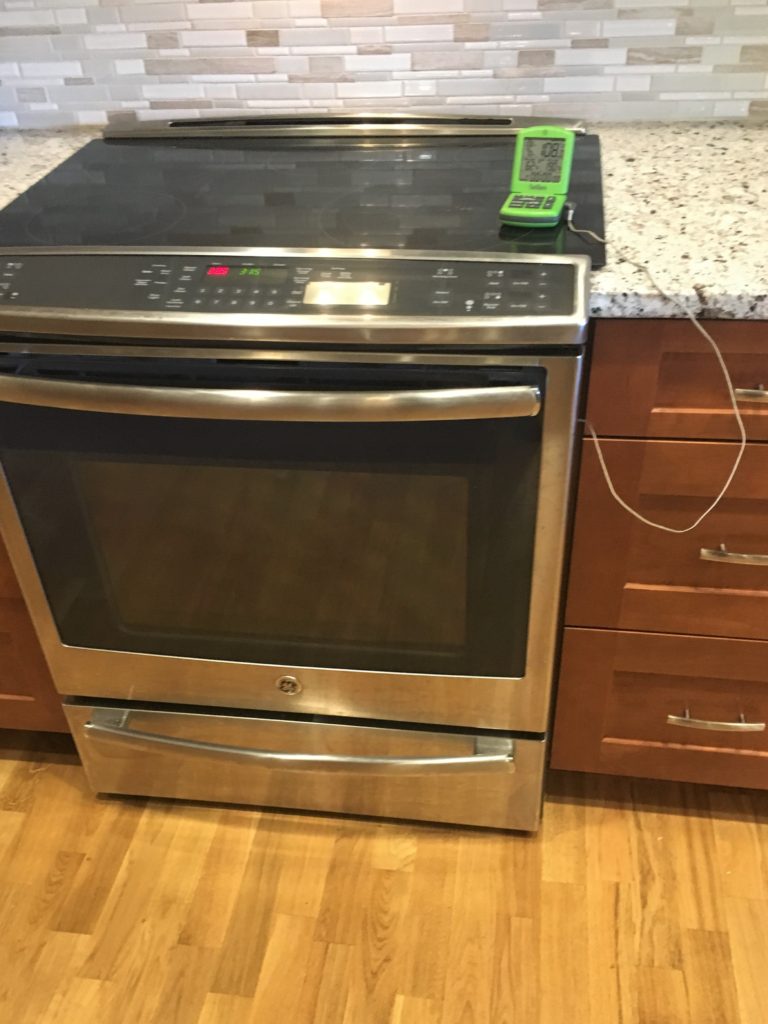
If you don’t have a leave-in, oven thermometer, you’ll want to check the brisket’s temperature after removing it from the oven with an instant read thermometer. The ideal temperature is between 180-200°F.
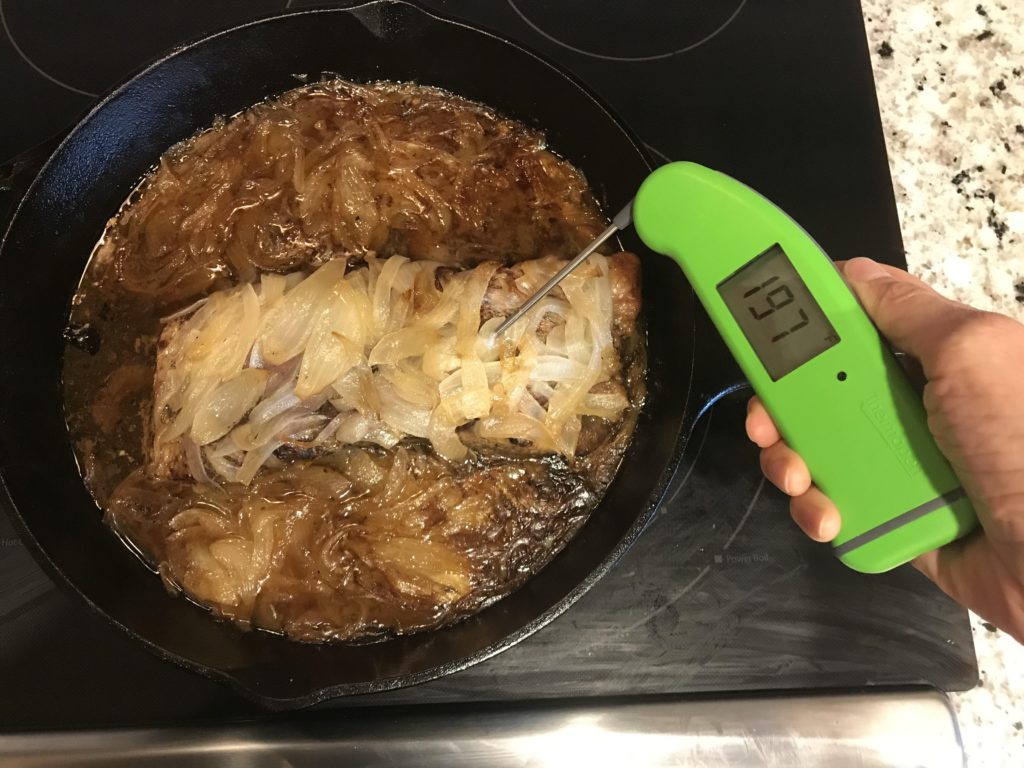
How Long Should Brisket Rest?
Like any good piece of meat, brisket must rest after cooking. Resting the meat lets the brisket’s fibers relax and widen so that juices redistribute throughout the cut of beef.
You absolutely must let the brisket rest for at least 20 minutes before slicing it. If you do, you’ll have tender, juicy slices of flavorful brisket. If you hurry and slice it too soon, you’ll loose the juiciness on the cutting board and the beef will be dry. Let it rest!
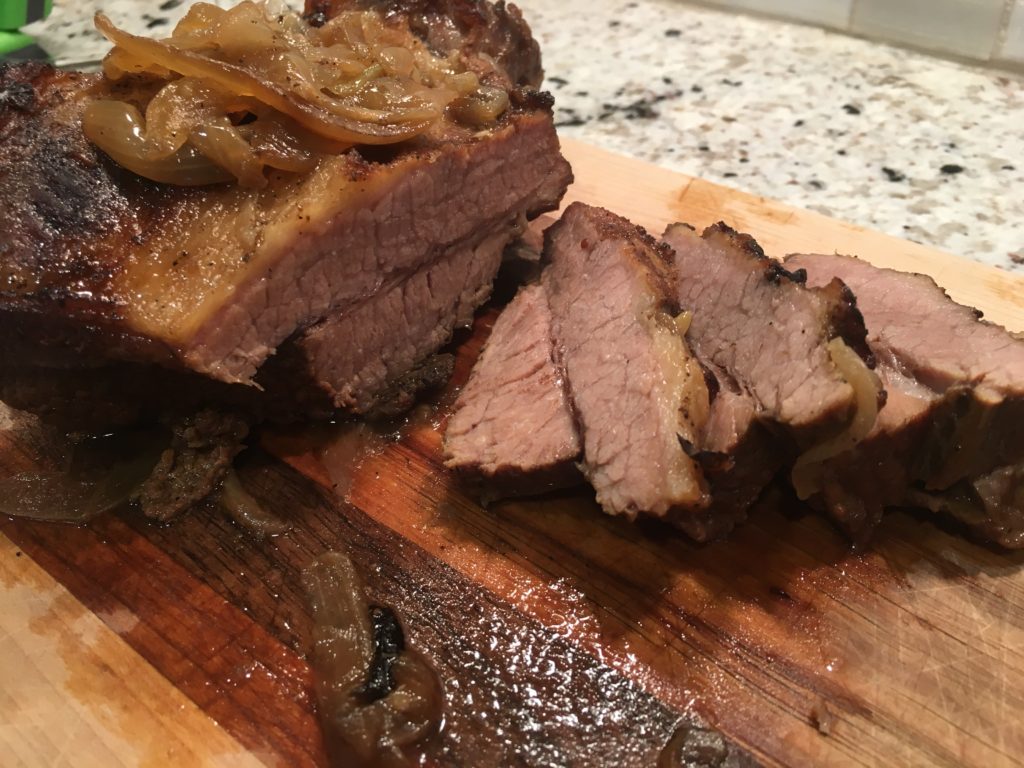
Cutting Brisket Against the Grain
In beef, the grain is referring to the direction the muscle fibers run within the piece of meat. Cutting against the grain means to cut through the fibers and make them shorter. This makes the meat more tender and easier to chew.
How do you cut meat against the grain? First, look at your meat and find the grain. Next, place your knife perpendicular to the grain. Then, cut the meat. That’s it! By cutting the brisket against the grain, you’ve just made it more tender.
How to Store and Reheat Brisket
- To store: Place any leftover brisket and meat juices into an airtight container and store in the fridge for up to 4 days or in the freezer for up to 3 months
- To reheat: Place your refrigerated or thawed leftover brisket and meat juices into a roasting pan or baking dish and heat in a 325°F oven until warmed to your liking.
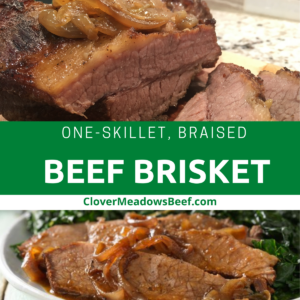
One-Skillet Braised Beef Brisket in Oven
Ingredients
- 4-5 pound Beef Brisket
- 3 tsp Olive Oil
- 3 Yellow Onions, Sliced
- 1/2 tsp Sugar
- 2 Tbsp Canola Oil
- 3 cloves Garlic, Minced
- 2 Tbsp Worcestershire Sauce
- 2 cup Beef Broth (homemade if possible)
- 1 Tbsp Liquid Smoke
Instructions
- Preheat oven to 300 degrees. Season brisket with kosher salt and pepper on both sides and set aside (See note below – if possible, season brisket with salt 8-24 hours in advance and let sit in refrigerator).
- Slice onions lengthwise, from root to stem.
- In a large cast iron skillet, add olive oil and coat bottom of skillet. Heat on medium high heat until the oil is shimmering. Add onions and cook for about 10 minutes, stirring often. After about 10 minutes, sprinkle some salt and ½ tsp of sugar onto the onions, which will help caramelize the onions. When they begin to caramelize, remove onions from skillet.
- Add canola oil to cast iron skillet and brown beef brisket on both sides on a medium-high heat. About 5 minutes on each side. Remove beef brisket from skillet.
- Add garlic, beef broth, Liquid Smoke and Worcestershire sauce to cast iron skillet and stir well (or, you can use a large roasting pan if you don't want to cook the brisket in a cast iron skillet).
- Place beef brisket in cast iron skillet fat side up. Top with onions.
- Cover tightly with foil or a lid, and place into a 300-degree oven. Cook until brisket is 180-200°F and fork tender, approximately 40 minutes per pound.
- Transfer beef brisket to a cutting board, slice against the grain, and serve.
Notes
- If you have the time, season brisket with salt the day before and place in the refrigerator 8-24 hours before cooking it. The salt will help break down the beef’s muscle protein, draws moisture to the surface of the meat, and ultimately has a hydrating effect.
- When seasoning the brisket, be sure to use kosher salt because the large granules cling to the beef better than other types of salt.
- I like to use homemade beef broth. If you don’t have it available, store bought is OK too.
Products we love
Other Brisket Recipes
Have beef questions? We are here to help!
Do you want to learn more about beef? You can contact us or below are a few popular beef posts and recipes you may like. In addition, we have an entire ebook about beef that goes through purchasing and preparing beef from a farmers perspective.
- Buying a Cow. How Much Beef Is It?
- Steak Doneness: Temperatures, Touch Test & Charts
- Defrosting Meat: 4 Safe & Easy Ways
- Slow Cooker Pepper Steak
- Prime Rib Roast with Garlic Herb Butter
- Liver and Onions (2 different ways)
We have a weekly e-newsletter where we share about farm happenings, when our next beef availability is, and all things beef. When you do, you’ll get a cheat sheet with 9-must-ask questions before buying beef directly from a farmer.
We participate in the Amazon Services LLC Associates Program, an affiliate advertising program designed to provide a means for us to earn fees by linking to Amazon.com and affiliated sites. See our disclosure policy for more details.


[…] Brisket: You could have this ground into ground beef, but please don’t. Brisket is so good and there are lots of ways to cook brisket. […]